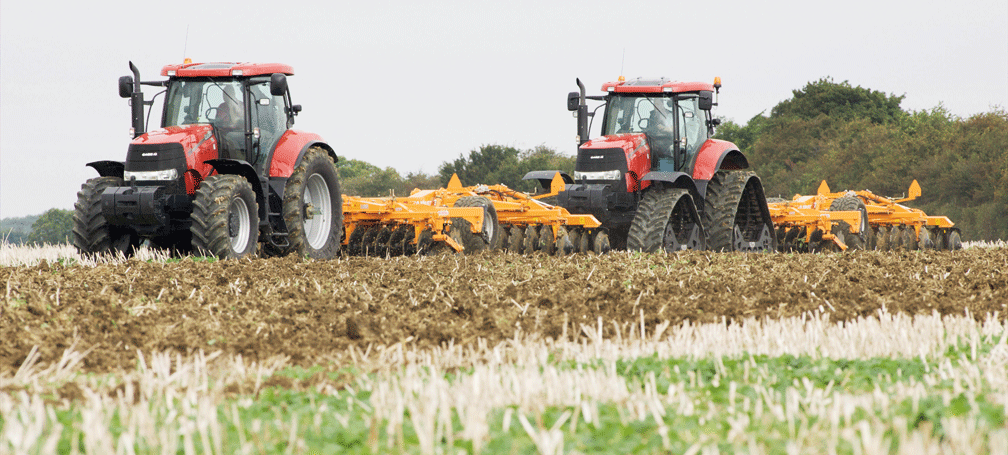Soucy tracks go head-to-head with tyres

Late last year, Cambridgeshire Case IH dealer Collings Bros started importing a bolt-on four-track system from Canadian firm Soucy called mini-Q tracks. For £30,000-£40,000, says Soucy, mini-Qs enable you to increase your tractor’s footprint more than threefold.
Because there is nearly three-and-a-half times more rubber in contact with the ground than with a tyre, traction is much improved and work rates boosted. Compaction is reduced, too, with ground pressures falling from more than 7.5psi for a 7t tractor to about 2.3psi.
All this sounds good on paper, but the actual payback in practice has been hotly debated. Studies from Alberta, Canada, looked at how tracks could alleviate compaction and the impact that has on crops. It found that yield improvements of 14-20% were possible in theory, although this was countered by growers in the USA, who found their results were closer to 1-2%.
Why the disparity? A study in Alabama, USA, provided a possible answer. It found that although the total area of rubber in contact with the ground was far greater with a twin-tracked machine than a tyre, the track units’ idlers, drive-wheels and rollers produced pressure spikes where they ran over the soil.

A correctly inflated radial tyre, on the other hand, was found to be able to distribute the machine’s weight more evenly over its smaller contact area. So ground pressures were reduced by using tracks, but not as much as might be expected when looking at total rubber area.
This was confirmed by a separate study comparing the performance of a large articulated tractor running on four rubber tracks with equivalent tractors running on dual wheels.
It found that when the tractor came under load, there was a tendency for the torque exerted to twist the track units so that the front dug in and the rear lifted. So the overall contact area was reduced when compared with the static footprint.
But it wasn’t all bad news for track fans – some significant benefits were found, too. At a slip rate of 5%, the tracked machine was found to be able to pull double the amount the wheeled machine managed. This was in extreme conditions – in normal going, track slippage rarely exceeds 3%, whereas wheelslip will often average 15-20%.
Other advantages for the four-track machine included a reduction in the low-frequency vibrations that tyres can induce and an absence of scuffing when turning – a common complaint about twin-track tractors which brake left or right tracks to steer.
As well as this, because the four individual track units are able to pivot (to a limited extent) around an axle, they have a greater tendency to keep their entire footprint in contact with the ground.
By contrast, a twin-track machine setting off into work will often roll back on to its rear drive wheels, which then carry the brunt of the weight. This effect can be particularly marked when working with mounted implements.
Tracks on trial

To find out for ourselves, we pitched two identical Case Puma 195s against each other, the only difference between the two being their running gear.
- Tractor 1: Goodyear Opitrac DTs – 540/65R30s on the front and 650/65R42s on the back (approx footprint = 1.8sq m).
- Tractor 2: Soucy mini-Q tracks – 635mm (25in) wide on the front and 812mm (32in) on the back (approx footprint = 5.7sq m).
Each was hitched to a 3.3m Simba Solo ST cultivator – a combination of discs, ripper-tines and press. We called in Simba’s cultivator expert, Mick Jessop, to check that both were set up the same and that each tractor had an identical drawbar load.
Both tractors’ diesel tanks were then brimmed and they set off to complete 10 timed runs of 200m. Although both were set to run at 1900rpm, the ultimate goal was to cover as much ground as possible – as you would in normal working conditions.
The wheeled Puma averaged about 6kph running at 1900rpm, most of the time in 9th gear. Wheelslip yo-yoed between 15% and 20% and it used 18.4 litres for its 10 200m runs. Average time for a run was 2min 14sec.
Average run time for the tracked tractor was 2min 13sec, so there wasn’t much in it when it came to straightforward work-rates. However, because track slippage never exceeded 4% with an average speed of 6kph, fuel use was almost half a litre less than the wheeled machine.
As well as maintaining a much higher level of traction, the mini-Q’s long footprint smoothed out undulations across the field, almost eliminating the nodding dog effect when crossing tramlines. Conversely, because the track units lack the damping effect of air-filled tyres, on the road every pebble gives a jolt.
Also, the smaller total circumference of the rubber belts compared with tyres means road speed is reduced from 40kph to 27kph. Turning circle isn’t affected, however.
Verdict
In normal conditions tracks don’t offer massively higher workrates. They do, however, limit slippage so less power and fuel is wasted.
Plus they offer a much bigger footprint which should result in lower compaction, although we weren’t able to measure that here.
Where they are bound to come into their own is in wet seasons like this one.
A tractor running on mini-Q tracks has a much greater chance of staying afloat than one running on standard rubber.

